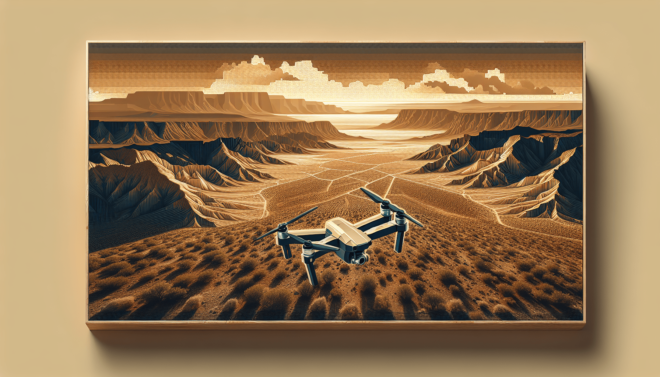Have you ever wondered if there are environmental concerns tied to drone flying in Las Vegas’ desert regions? If so, you’re not alone. With advancements in technology, drones have become more accessible, leading to increased use in recreational and professional settings, especially in unique landscapes like the deserts surrounding Las Vegas. But what impact does this trend have on the environment? Let’s dive into the details and explore this topic in-depth.
Introduction to Drones in Las Vegas’ Desert Regions
Drones, also known as unmanned aerial vehicles (UAVs), have taken the world by storm. In the sun-soaked desert areas surrounding Las Vegas, these fascinating gadgets offer new perspectives for photography, filmmaking, and even scientific research.
The Popularity of Drones
The allure of capturing breathtaking desert vistas or performing aerial surveys has attracted many to use drones in these regions. The expansive open skies and sweeping landscapes provide ideal conditions for drone flights. However, with this surge in usage, it’s important to consider the potential environmental impacts.
Purpose of This Article
The goal here is to inform you about the possible environmental concerns that come with flying drones in Las Vegas’ desert regions. Whether you’re a drone enthusiast or a concerned environmentalist—or both—this article will equip you with comprehensive information on the topic.
Environmental Impact Concerns
The environmental impacts of drone usage can be categorized into several key areas, including wildlife disturbance, noise pollution, and ecosystem degradation. Let’s explore each of these in more detail.
Disturbance to Wildlife
Drones can be particularly disruptive to wildlife, which relies on the tranquil environment of deserts for survival.
| Wildlife | Possible Impact from Drones |
|---|---|
| Birds | Disturbance during nesting and migration |
| Mammals | Stress and behavioral changes |
| Insects | Disruption in natural activities |
Birds
Birds are especially vulnerable to drones. Many species use desert regions as critical nesting and migration grounds. The presence of drones can cause birds to abandon nests or alter their migratory paths. This can have cascading effects on their breeding success and population stability.
Mammals
Desert mammals like the kit fox and desert tortoise may experience significant stress due to drone activity. The sudden appearance and noise of drones can interfere with their natural behaviors, causing them to flee or hide, which affects their feeding and mating activities.
Noise Pollution
Noise pollution is another significant concern linked to drone usage. While drones are generally quieter than traditional aircraft, their engines still produce noise that can be unsettling in the otherwise serene desert environment.
Decibel Levels
The noise produced by drones can vary, but it generally falls within a range that can be disruptive to both humans and wildlife.
| Drone Type | Noise Level (decibels) |
|---|---|
| Small Recreational | 60-70 dB |
| Large Professional | 75-85 dB |
Even at the lower end of this spectrum, noise pollution can disturb the peace of the desert, impacting both wildlife and the experience of human visitors.
Ecosystem Degradation
The desert ecosystem is a delicate balance of limited resources and specialized organisms. Drones can contribute to the degradation of this fragile environment in several ways.
Soil Erosion
Repeated takeoffs and landings can disturb the soil, leading to erosion. The thin layer of desert soil is crucial for plant life and, subsequently, the entire food chain.
Introduction of Invasive Species
Drones can inadvertently introduce invasive species to the desert environment. This could occur if drones or their operators carry seeds or microorganisms from other areas. These non-native species can upset the ecological balance by outcompeting local flora and fauna.
Regulations and Guidelines
To mitigate these environmental concerns, several regulations and guidelines have been put in place regarding drone usage.
Federal Aviation Administration (FAA) Rules
The FAA mandates certain flying rules that can help in reducing environmental impacts.
| Requirement | Description |
|---|---|
| Flight Altitude | Drones must fly below 400 feet to avoid air traffic |
| Near Wildlife | Operators are advised to avoid flying near wildlife areas |
| Remote ID | Drones must be capable of identifying themselves remotely |
Local Restrictions
In addition to federal rules, local restrictions apply to sensitive areas to protect ecosystems.
| Area Type | Restrictions |
|---|---|
| National Parks | Drones are generally prohibited |
| Wildlife Reserves | Restrictions vary; permits may be required |
| State Parks | State-specific regulations; usually more restrictive |
Best Practices
Following best practices can also help mitigate environmental impacts.
- Fly Responsibly: Always be aware of your surroundings and avoid flying near wildlife.
- Stay Informed: Keep up-to-date with local regulations and guidelines.
- Minimize Noise: Opt for quieter drone models and avoid prolonged flights.
- Leave No Trace: Ensure that your drone operations do not leave any debris or footprints in the desert environment.
Balancing Drone Usage and Environmental Preservation
It’s possible to enjoy the benefits of drone technology while minimizing its environmental impacts. Both hobbyists and professionals can take steps to protect the fragile desert ecosystem.
Ethical Considerations
As drone operators, being ethically responsible means recognizing the impact of our actions on the environment and making conscious choices to mitigate harm.
Educational Opportunities
Drones also offer unique opportunities for education and conservation.
| Educational Use | Environmental Benefit |
|---|---|
| Research | Data collection on wildlife and ecosystems |
| Monitoring | Tracking of endangered species |
| Awareness | Creating awareness through photography and video |
Closing Thoughts
While drones offer incredible opportunities for exploration and innovation, it’s crucial to acknowledge and address the environmental concerns associated with their use. By adhering to regulations, following best practices, and employing drones responsibly, we can enjoy the benefits of this technology while safeguarding the delicate desert ecosystems of Las Vegas.
Your actions as a drone operator can make a significant difference. How will you ensure that your drone usage remains environmentally conscious in these sensitive desert regions?

